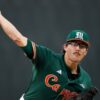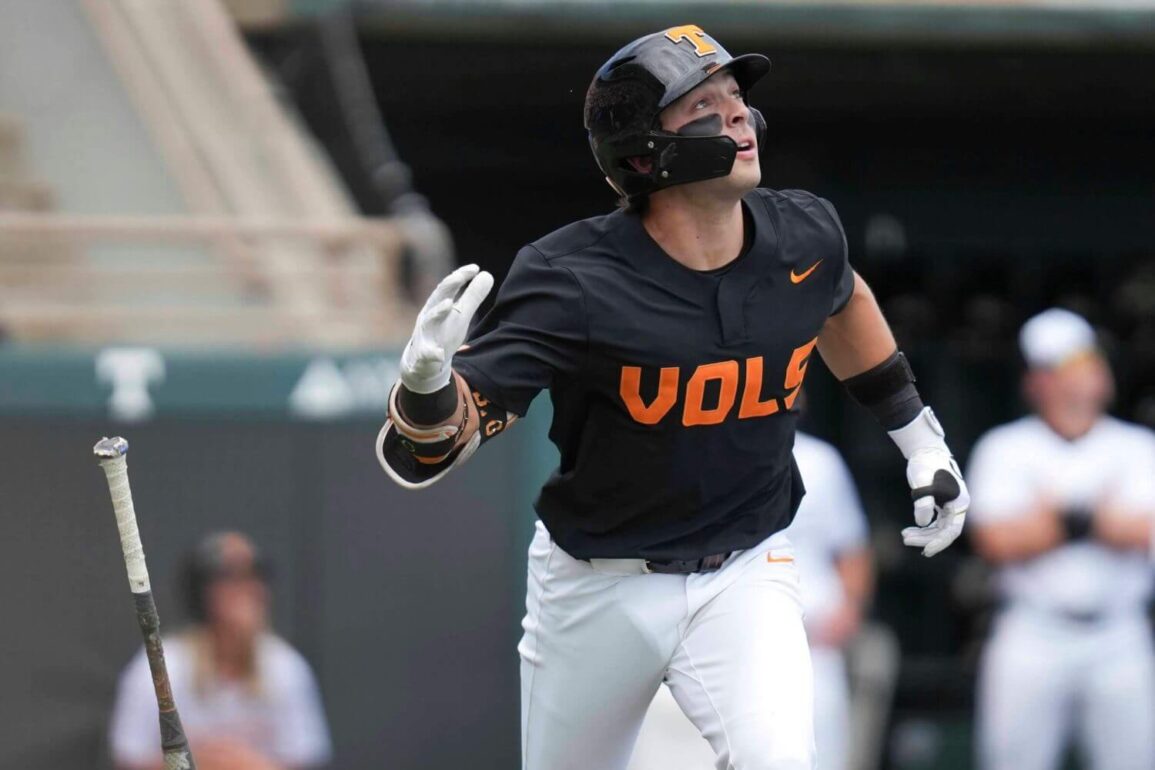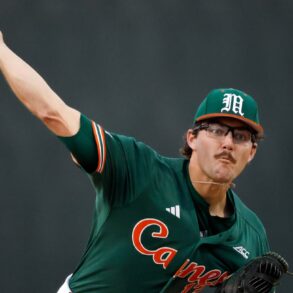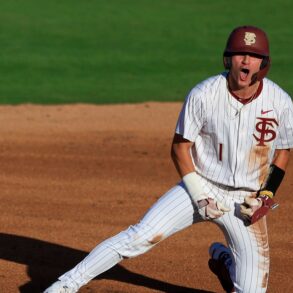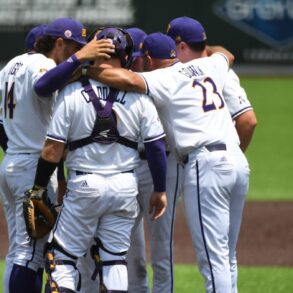College baseball has spent much of the last three decades bouncing between offensive extremes, from the gorilla ball to the dead ball and back to a bombs-away mentality.
The latest swing in the state of play has produced an unprecedented four-year run of power hitting. Unlike some of the other recent fluctuations, the latest uptick in offense has those in the game less worried about the balls and the bats and more focused on the guys using the equipment and how.
Advertisement
“I just think teams are a lot bigger and a lot stronger than they used to be,” said Arkansas coach Dave Van Horn, who has led his teams to nine College World Series appearances in 36 years as a head coach. “They’re a lot older than they used to be.”
According to NCAA records dating back to 1970, there have been four seasons in which Division I teams averaged a home run per game: 1998 and the past three seasons. Heading into the NCAA regionals, this season is on pace (1.06 homers per team game) to be the fifth overall and fourth straight.
Instead of fretting about the abundance of dingers, the game’s leaders see it as a natural evolution brought about by a combination of mostly positive developments.
“I think the college game’s in a great spot,” UC Irvine coach Ben Orloff said.
Homer history
The college game’s first brush with the outer limits of recognizable baseball came in 1998, the same year the pursuit of the MLB single-season home run record captivated the big leagues. Division I records for runs (7.12) and home runs (1.06) per team per game were set. Former LSU coach Skip Bertman was credited with coining the term “gorilla ball” to describe the state of the college game at the time.
The punctuation came at the College World Series, when USC beat Arizona State 21-14 in a championship game that featured nine home runs. At least one team reached double-digits in runs scored in seven of the 14 games in Omaha.
The NCAA and college baseball leaders decided it was time to cool off the bats, in the name of bringing balance back to the game and protecting the players most likely to be injured by close-range line drives. Working with sports scientists, they sought to devise a way to measure how fast the ball was coming off the bat and ensure non-wood bats performed no better than the best-performing wood bats.
Advertisement
“(Non-wood bats) have what is known as a trampoline effect,” said Alan Nathan, professor emeritus at the University of Illinois who has done extensive research on bat-to-ball physics. “So when the ball hits the surface of the bat, the bat itself, which is hollow, the surface of the bat can compress and then spring back much, much like a trampoline, and you get a bigger kick to the ball. So you get higher exit velocities that way.”
Ball Exit Speed Ratio (BESR) testing was introduced after the 1998 season, and home runs and runs steadily dropped for about 10 years, but they ticked up in 2008. By 2010, home runs were again approaching one per game, and runs were up near 7.0. Again, safety became part of the conversation. A new standard for measuring how the ball comes off the bat called the Batted Ball Coefficient of Restitution (BBCOR) was implemented in 2011.
Again, adjusting the bats worked — too well.
Offense cratered. In 2014, home runs were down to 0.39 per team per game. Runs per game hit levels last seen in college baseball when wood bats were still being used in the early 1970s. The switch to aluminum bats came in 1974.
At the 2014 College World Series, UC Irvine coach Mike Gillespie told The Associated Press the bat change was a “nightmare.” TCU coach Jim Schlossnagle added, “It’s just a travesty what we’ve done to college baseball.”
Only three home runs were hit over 16 CWS games. Vanderbilt won it, with a homer in the deciding game providing the winning run in a 3-2 victory against Virginia. The Commodores finished that season with 22 homers over 72 games.
This time, the ball took the fall. The next season the NCAA began using a ball more similar to what is used in the Major Leagues, with flattened seams that allow it to cut through the air with less drag.
“When you lower the seams on the ball, the ball isn’t coming off the bat any faster,” Nathan said.
Advertisement
Once again, the adjustment worked. Long balls increased immediately and steadily climbed for a few years. In 2019, Vanderbilt won another national championship, and Commodores outfielder JJ Bleday blasted 27 homers by himself.
In 2022 there was another surge in homers (1.03 per game) to near 1998 levels. That set the stage for a record-breaking number of homers in 2023 (1.14 per game) and another in 2024 (1.16).
This time, though, no adjustments were made. And things have already ticked back down, though compared to historical norms, home runs are still flying out of college ballparks at a rate akin to the gorilla ball days. There is a distinct difference between the two eras.
“The home run was prevalent by those that could really hit them,” said ESPN college baseball analyst Chris Burke, a former major leaguer and 2001 first-round draft pick out of Tennessee. “But nobody was necessarily teaching the (swing) path that produced that result. There was still a lot of old-school teaching around that era of the game, and so while the equipment was really designed for a bunch of home runs the instruction was not nearly as intentional as it is today.”
The rise has been driven by the top conferences.
Homers per team per game
| League | 2021 | 2022 | 2023 | 2024 | 2025 |
|---|---|---|---|---|---|
|
SEC |
1.29 |
1.47 |
1.62 |
1.68 |
1.54 |
|
ACC |
1.25 |
1.56 |
1.46 |
1.68 |
1.32 |
|
Big 12 |
1.11 |
1.22 |
1.28 |
1.34 |
1.21 |
|
Big Ten |
1.03 |
1.19 |
1.19 |
1.23 |
1.27 |
|
Pac-12 |
0.96 |
1.07 |
1.4 |
1.19 |
N/A |
The bats
While the ping of a metal bat making contact was once a trademark of college baseball, carbon-fiber composite bats are now far more common. Generally, composite bats offer larger barrels while feeling lighter when swung because of how they are proportioned. They can crack and break like wood bats — though not as easily — and unlike aluminum bats, they perform better when broken in.
Composite bats can also be altered to improve how the ball springs off them (the so-called trampoline effect) and surpass the NCAA standards that have been established (and re-established) over the past 25 years. The most common ways are called shaving and rolling, and a simple online search will produce plenty of bat doctors, selling services and bats that will supposedly put some extra juice on your fly balls.
Advertisement
Shaving requires removing the end cap of a bat, which can be difficult to do, and shaving down or thinning out the inner wall of the barrel. That makes the bat more springy.
Rolling is less involved and is designed to replicate heavy usage. A rolling machine breaks down the bat evenly and produces an accelerated break-in.
Getting doctored bats into a game, though, is not so easy. NCAA rules require bats to be tested using a three-step protocol that includes the use of a bat compression tester. Bats that pass are labeled with a tamper-proof sticker. and only stickered bats can be used in games.
This season the NCAA changed its rules to require bat testing before every game. Previously, bats were tested before every series, though the ACC and SEC both switched to day-of-competition testing last season.
Is the system foolproof? Is anything?
There have been no verified cheating scandals in college baseball recently, and coaches don’t seem to be particularly worried about an epidemic of doctored bats undermining their sport. But baseball being baseball, skepticism and suspicion come with the territory.
The Vanderbilt-Tennessee rivalry got spicy in 2022 when Vols slugger Jordan Beck had a home run against the Commodores waved off by umpires because it didn’t have the appropriate sticker. Vandy coach Tim Corbin implied that it might not have been an innocent mistake.
Sometimes suspicion can lead to teammates accusing teammates.
After the 2024 college baseball season, a player at a Power 4 school alleged some of his teammates were using — for at least part of the season — doctored bats, attorneys working with the player have told The Athletic. The attorneys brought the allegations and supporting evidence to the conference office, which directed attorneys to share what they had with the school. A few months later school officials told the attorneys they had found no wrongdoing in their baseball program. A school official told The Athletic a thorough investigation was done that involved interviewing players and coaches.
Advertisement
“The only reason you could slide an illegal bat under the radar is because you have humans testing them,” Clemson coach Eric Bakich said. “And those humans are usually representative of each institution, so it’s not like a neutral third-party, like an umpire is testing. But I think that’s probably the next evolution of bat testing. But I don’t think it’s a problem. I haven’t seen it be a problem.”
Bakich added, “My assumption is that that feels pretty reined in just the amount of testing that goes on with those bats every day.”
Nick Smith, deputy director of Washington State’s sports science lab, which has worked with the NCAA on setting the standards for non-wood bat performance, said the lab will send bats out to rolling services and test them. What they generally find is the bats still remain within the testing standard upon return. Charging customers for bats that can’t pass inspection is probably not great business, Smith said.
So if a bat is doctored to accelerate the break-in period and improve its performance, but that performance still falls within the rules, is it cheating?
Smith also said bat manufacturers are now designing bats in ways that mitigate the effects of rolling.
“That’s a form of bat doctoring that’s very easy for us to replicate, and it’s now part of our standard test. So I think there are probably other ways people can cheat and gain an advantage,” said Smith, whose father Lloyd invented the compression testing device used by schools to measure the BBCOR of bats. “I think rolling is one where they’re unlikely to gain any advantage beyond placebo.”
The offensive uptick hasn’t prompted calls for change or increased scrutiny because there are plenty of organic contributing factors. Wake Forest coach Tom Walter, whose program has been at the forefront of the long-ball craze with 465 homers over the past four seasons, said baseball has a long history of players looking for any advantage they can find.
Advertisement
“Do I think there are programs out there that are probably pushing that envelope there? There are, I’m sure they are,” Walter said. “And if they’re not doing it as a program, there’s probably individual kids that are trying to figure that out and figure out how to beat the system. I think that we’re always going to be dealing with that. And I think college baseball has done a good job of reacting to the times.”
Shrinking minor leagues and paying college players
In 2020, as the pandemic disrupted high school, college and professional baseball seasons, MLB shortened its draft to five rounds from its usual 40. The next year, in conjunction with the contraction of Major League-affiliated minor league baseball, the draft was permanently cut in half to 20 rounds.
Meanwhile, the NCAA chose not to count 2020-21 participation toward athletes’ eligibility clocks, creating a horde of fifth-, sixth- and even seventh-year college athletes in recent years.
Add those two pandemic ripple effects together, and it’s been a crowded few seasons in college baseball.
“We’ve got a couple guys on our team that are 24, about to turn 25,” Bakich said. “Just having a lineup with 22-, 23-year-old guys in your lineup is the new normal for a lot of programs. There’s less and less 18-year-old, 19-year-old freshmen. As kids continue to develop, power is usually one of the things that comes last.”
And while baseball players aren’t generally receiving the high six-figure or even seven-figure deals football and basketball players are getting, there is money to be made in college, and the quality of life is often better than in the minor leagues.
“College baseball is the best farm system for Major League Baseball,” Bakich said. “The tippy-top of college baseball usually has a Double-A or Triple-A facility and is giving these kids the big-league treatment in terms of travel, accommodations, food, et cetera. So these kids, they go to summer ball, it’s a letdown. They go to Single-A and it’s a letdown.”
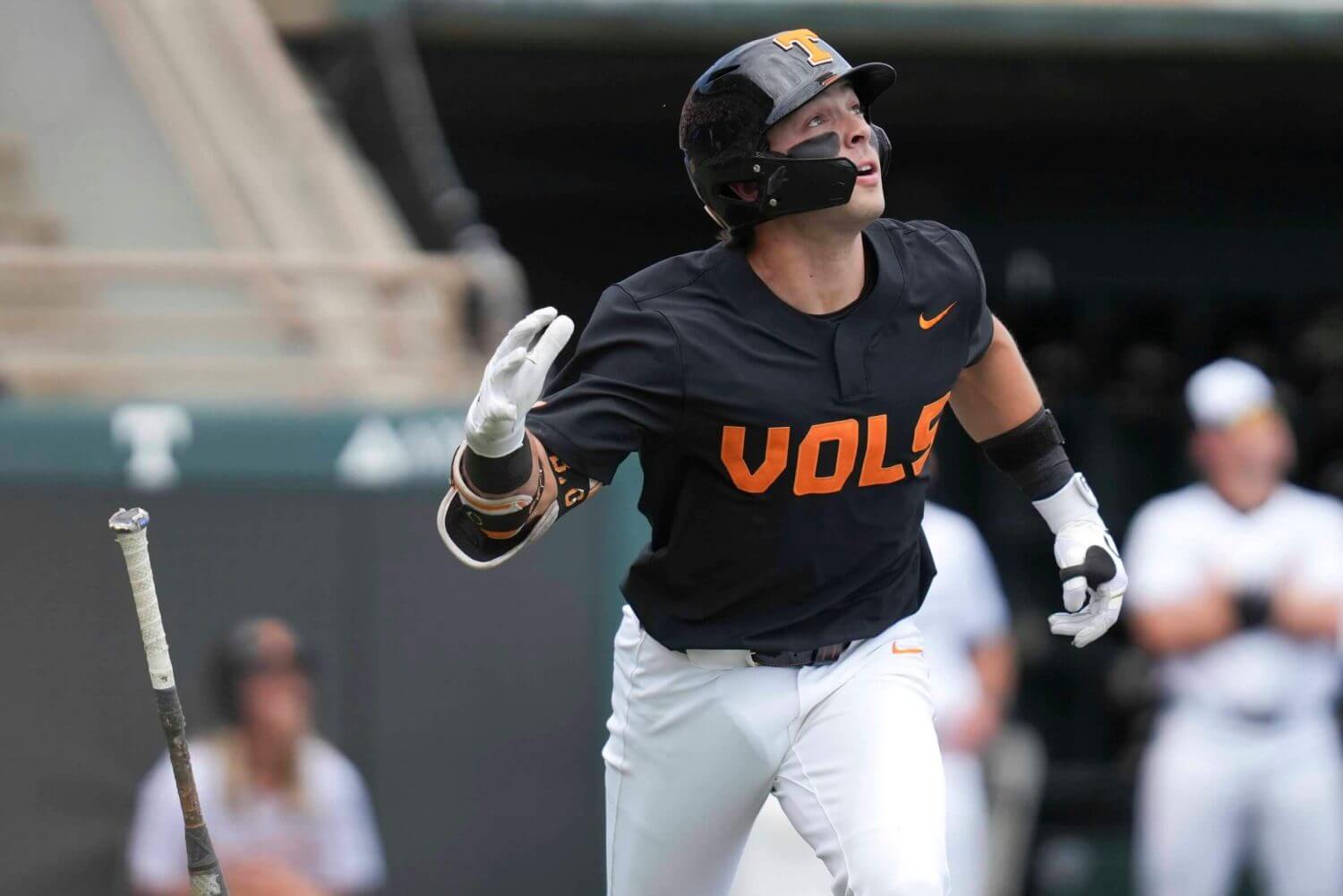
Tennessee, which used a deep stable of power hitters to win its first national championship in 2024, is third in D-I in home runs this year.
Style of play
Just like in 1998, the offensive environment in college baseball echoes what is happening in Major League Baseball.
Strikeouts have been steadily climbing against pitchers who have more tools, technology and data at their disposal than ever before to improve velocity and movement. Depending on a team to string together hits — or even contact — to score multiple runs in an inning against pitchers with nasty stuff is a hard way to win.
Advertisement
It’s all about launch angle and exit velo. Lift the ball and hit it hard.
“The data shows that we want our guys kind of living in that 12- to 18-degree launch angle range,” Walter said. “And I get why, because some of your misses are home runs, and then some of your misses are hard ground balls, right? So you want guys to live a little bit higher launch angle because your misses are more productive.”
Walter, whose program has prided itself on being at the cutting-edge of baseball’s tech and data revolution, also said the strike zone is shrinking because of ball-tracking technology used to evaluate umpires. Pitches barely on, or in many cases slightly off, the outside part of the plate that were frequently called strikes aren’t anymore.
“These umpires are getting evaluated on TrackMan every single game, and I think they’ve learned that if they want a good score, they’ve got to keep it on the plate,” he said.
Add in an uptick in hitter-friendly parks around the country and sprinkle on top of that a little climate change — warm temperatures help baseballs fly farther — and conditions have never been more conducive for homers.
And these days, that’s just fine. Ratings for the last two College World Series have set new highs for ESPN and the college game is continuing to fill in the developmental gap left by minor-league contraction. While scoring remains high compared to historical norms (teams are combining for a little under 14 runs per game overall), why mess with a seemingly good thing?
“I do think the best time for college baseball is ahead of us,” said Craig Keilitz, the longtime executive director of the American Baseball Coaches Association. “As good as we are right now, I think we got a brighter future, so I’m really excited about the future of our game.”
(Top photo: Corey Perrine / Florida Times-Union via Imagn Images)
This post was originally published on this site be sure to check out more of their content.


